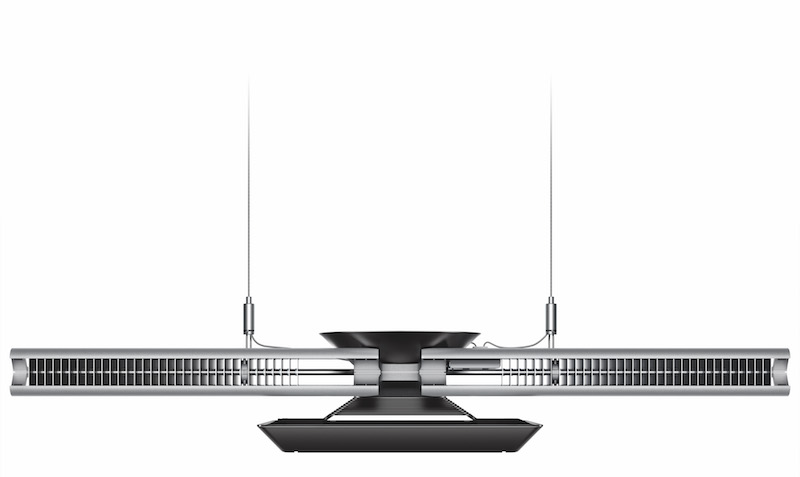Dyson is mostly known for its (expensive) vacuum cleaners that claim to never lose suction and have the ability to get every inch of your carpet clean, but Dyson’s newest invention isn’t a new super powerful or ultra quiet vacuum cleaner, in fact, it isn’t a vacuum cleaner at all; it’s the Cu-Beam Duo, a light that is rated to operate for 22 years without a bulb change.
As Fastcodesign.com reports, the Cu-Beam Duo is a new lighting system that uses just two LEDs, not the hundreds that most commercial lighting fixtures use, to light the space below the fixture, above the fixture, or a combination of the two. Each LED is about the size of a quarter, massive for LED standards, and is fitted with custom-engineered lenses to spread the glow over a larger area. One LED provides the light for task surfaces below while the other provides the ceiling light, which is optimal for illuminating open spaces like atriums, or offices.
The actual lights make up just a small portion of the 28-inch fixture, however. The rest is a large heat sink with the sole purpose of keeping the LEDs cool because a cool LED can run for a very long time without fading or discoloring. The Cu-Beam Duo uses heat pipe technology to cool the two LEDs.

The Cu-Beam Duo uses six vacuum-sealed heat pipes to transfer heat away from the light source to be dissipated along the wings. Each tube contains a drop of water. When the light is turned on, the heat turns the water into vapor. The vapor then disperses throughout the pipe and, when it reaches a cool area of the tube, condenses back into water. A copper wick then draws the water back toward the heat source and the process starts again.
The idea to cool LEDs with a heat pipe was first used in the CSYS desk lamp, a lamp that came with the promise of running for 40 or 50 years without needing to change the bulb. The Cu-Beam Duo takes this initial technology and improves and expands upon it.
The stock light puts out 8,500 lumens but it can be changed and fitted with a 20,000 lumen LED. Additionally, there are sensors that can detect when no one is at the table or workspace below and shut off the down light, leaving just the up beam on to keep the room illuminated. Additionally, the each lamp has internal shutters that can crop the down beam to the width of the table below with no spill. The crop light is not wasted, though. The Cu-Beam Duo uses "Ricochet" technology to convert any unwanted down light into up light.
The Cu-Beam Duo has not been priced yet, but the company says it was designed with the intention of being used for large-scale, commercial products. The lights will be available in silver, black, and white with Dyson offering a range of custom colors, as well.
Related Stories
| Aug 11, 2010
Piano's 'Flying Carpet'
Italian architect Renzo Piano refers to his $294 million, 264,000-sf Modern Wing of the Art Institute of Chicago as a “temple of light.” That's all well and good, but how did Piano and the engineers from London-based Arup create an almost entirely naturally lit interior while still protecting the priceless works of art in the Institute's third-floor galleries from dangerous ultravio...
| Aug 11, 2010
Great Solutions: Green Building
27. Next-Generation Green Roofs Sprout up in New York New York is not particularly known for its green roofs, but two recent projects may put the Big Apple on the map. In spring 2010, the Lincoln Center for the Performing Arts will debut one of the nation's first fully walkable green roofs. Located across from the Juilliard School in Lincoln Center's North Plaza, Illumination Lawn will consist ...
| Aug 11, 2010
Gold Award: Eisenhower Theater, Washington, D.C.
The Eisenhower Theater in the John F. Kennedy Center for the Performing Arts in Washington, D.C., opened in 1971. By the turn of the century, after three-plus decades of heavy use, the 1,142-seat box-within-a-box playhouse on the Potomac was starting to show its age. Poor lighting and tired, worn finishes created a gloomy atmosphere.
| Aug 11, 2010
AIA course: MEP Technologies For Eco-Effective Buildings
Sustainable building trends are gaining steam, even in the current economic downturn. More than five billion square feet of commercial space has either been certified by the U.S. Green Building Council under its Leadership in Energy and Environmental Design program or is registered with LEED. It is projected that the green building market's dollar value could more than double by 2013, to as muc...
| Aug 11, 2010
Let There Be Daylight
The new public library in Champaign, Ill., is drawing 2,100 patrons a day, up from 1,600 in 2007. The 122,600-sf facility, which opened in January 2008, certainly benefits from amenities that the old 40,000-sf library didn't have—electronic check-in and check-out, new computers, an onsite coffeehouse.







